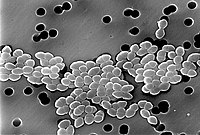
Photo from wikipedia
We have shown for the first time that it is possible to use a bacteria-based sensory system consisting of the bacterium Pseudomonas putida TSh-18 and an electro-optical sensor to detect… Click to show full abstract
We have shown for the first time that it is possible to use a bacteria-based sensory system consisting of the bacterium Pseudomonas putida TSh-18 and an electro-optical sensor to detect ampicillin in the concentration range 0.5-600 μg/mL. Changes in the anisotropy of cell polarizability were detected at 900 and 2100 kHz; these represented the state of the cytoplasm and of the cell membrane, respectively. The changes indicate the quickest cell response to changes in the characteristics of the bacterial culture exposed to ampicillin. We have also shown that it is possible to monitor the ampicillin in the presence of kanamycin. In control experiments, we examined the effects of ampicillin and kanamycin on bacterial cells by phase-contrast microscopy and by standard microbiological tests on solid media. P. putida TSh-18 is recommended as a sensor system for ampicillin detection. Electro-optical analysis ensures detection of ampicillin in aquatic solutions in real-time, takes 10 min, and offers a lower limit of ampicillin detection of 0.5 μg/mL, which is lower than the European Community's maximum residue limit standards for penicillin antibiotics.
Journal Title: Talanta
Year Published: 2021
Link to full text (if available)
Share on Social Media: Sign Up to like & get
recommendations!